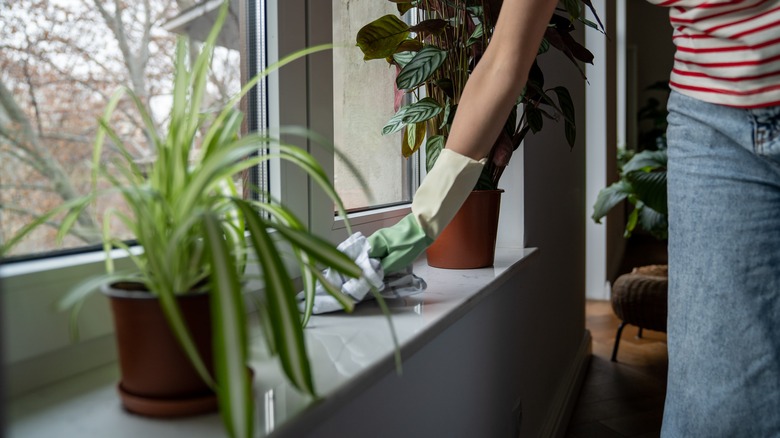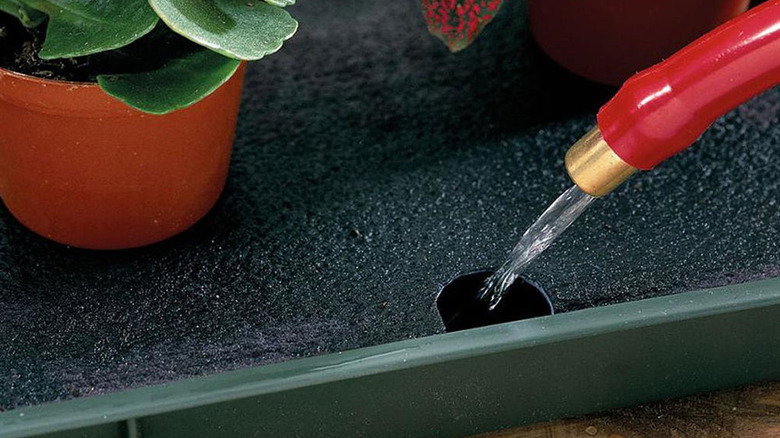Save Wooden Window Sills From Plant Water With These Genius Tips
We may receive a commission on purchases made from links.
You've marked the best time of day to water your houseplants in your planner. You know which of your green-leafed children love the sun and which prefer dappled shade and a spot near the AC. Repotting is a breeze now that you have a dedicated station in that disused corner of the kitchen. But right when you think you've got houseplant husbandry down, another puzzle pops up that needs solving. The issue at hand, in this case, is keeping your pristinely painted yet also plant-populated indoor window sills free from unsightly water stains — or, more aptly, dirty, iron-colored water stains. You might even have mildew or mold growth if the water penetrates old paint, leading to more serious issues or even window sill replacement.
Fortunately, the (relatively easy) solution lies in protective additions to your houseplants' housing. Arguably the most attractive option is to cut a sheet of thick plexiglass or polycarbonate to fit your window sill exactly. Choose a hue to match your sill, or go transparent if you prefer to keep things more minimalistic — both are discreet options. The materials are waterproof, so any overflow from planters placed on top will just sit there until you wipe it away. It's light, so you can also lift the sheet off easily to rinse it off elsewhere. You can also use something inside the planter drip trays to soak up overflow (think a circle of cork or felt) or invest in self-watering planter trays that match the dimensions of your window sill.
Using acrylic or polycarbonate sheet on sills
It could be that your houseplant isn't absorbing water, and the liquid is spilling over the planter's edges, though there are several other causes for leaking houseplants that are more likely — even the most absent-minded indoor gardener would notice surface-level overflow, right? Since most houseplants prefer free-draining soil, not using a drip tray with them allows for better airflow and drainage. However, it also means that if you ever water them a bit too enthusiastically, some water is bound to run through the soil, escape the drainage holes, and end up on your window sill. Even if you use a protective saucer under your planters, it's always possible to overwater them to the point that liquid fills the drip tray and spills over the lip.
Thus, what you need is something easy to clean to protect the window sill from water infiltration. A piece of acrylic sheet (plexiglass) or polycarbonate (PC) placed over your sill with your plants atop it offers excellent protection. It's water resistant, relatively inexpensive, and pretty much invisible when placed on a wooden window sill — or a shelf since it would easily work for that, too. Simply measure your sill, and then take those measurements with you to your local hardware or craft store. You could also shop online for a sheet the same color as your window sill paint. If you can't match the exact hue, choose a transparent sheet. Amazon sells 12 x 24 inch (wide and long) and half-an-inch thick clear polycarbonate sheets for $46.99.
Alternative options for window sill protection
If you're heading to the local hardware or craft store, don't be afraid to ask the staff to cut the sheet to your specifications. Alternatively, if you're handy, bring it home and cut the sheet yourself. The downside of acrylic sheets is that they're brittle, meaning the material cracks and scratches easily. However, it's pretty easy to cut with conventional home workshop tools. On the other hand, polycarbonate sheets are trickier to cut than acrylic but more flexible and robust, meaning they're likely to last longer.
There are other, easier window sill-protective options worth exploring, too. Use plastic, not ceramic, drip trays — the latter is porous and can leak. Place a piece of felt, cork, or other absorbent material between the saucer and the planter to absorb any overflow. A long, deep tray made from a waterproof material — think metal, glass, or glazed ceramic — works well. Match the dimensions of your indoor sill, fill the tray with river stones for extra drainage, and place your planters on top.
Ensure you clean it out regularly to avoid algal build-up. This is also one of the many reasons you should be bottom-watering your houseplants. Essentially, instead of watering the top of the soil in your planter, pour water into the drip tray underneath the pot instead. You'll know exactly how much water to add before the saucer overflows, preventing stains from forming. A self-watering window sill tray helps you do just that without any DIY needed. Get a Garland self-watering window sill plant tray from Greenhouse Megastore for $19.30.


